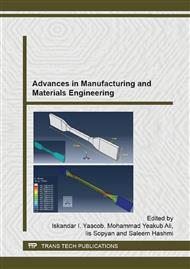p.578
p.585
p.589
p.596
p.601
p.606
p.610
p.616
p.622
Ranking of Manufacturing Attributes Affecting Bread Quality: Application of Analytic Hierarchy Process
Abstract:
Bread is considered as a prime item of cereal intake globally. Due to the rising public health concerns and their dietary needs, importance of identifying the factors in bread making, and taking necessary action plans can hardly be overemphasized. Moreover, to be competitive in business it is crucial for any bread maker to address the manufacturing factors or attributes to reduce the rejection level due to poor quality. This study makes an attempt to identify those attributes and rank them through application of analytic hierarchy process (AHP). The questionnaire is prepared to judge the ranking of initially identified five prime attributes such as ingredient quality, processing time and procedure, environment and workers’ skill. The responses by the manager, supervisor, line leader and quality control inspector on pair-wise comparison scale are collected and analyzed by using Expert Choice software along with the verification of inconsistency value. According to the results, quality of ingredient is ranked first followed by the processing time of the bread, production procedure, worker’s skill, and production environment. Since the inconsistency level is found to be below the threshold value, policies can be adopted safely in accordance with the ranking of factors to uphold the quality of bread and reduce the rejection level.
Info:
Periodical:
Pages:
601-605
Citation:
Online since:
July 2015
Authors:
Price:
Сopyright:
© 2015 Trans Tech Publications Ltd. All Rights Reserved
Share:
Citation:


